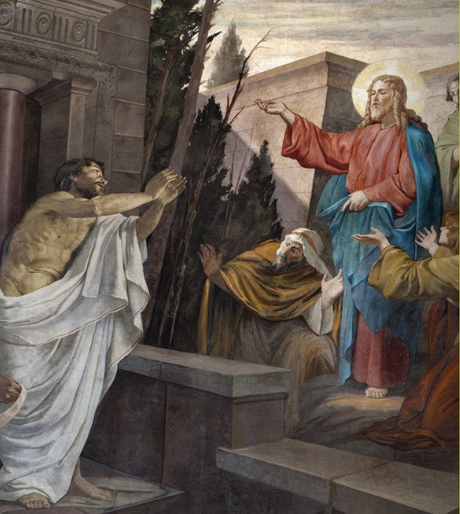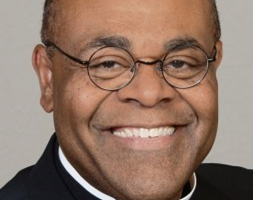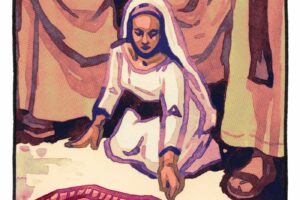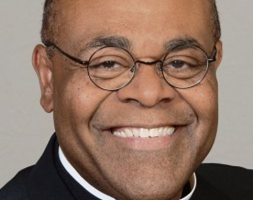
5th Sunday of Lent- “Those Who Believe in Me, Even though They Die, Will Live.” (Jn 11:1-45)
From Fr Johnson’s Homily for this weekend.
In the Gospel, Jesus reveals that he is the giver of life by raising Lazarus from the dead. By raising Lazarus from the dead, Jesus proves that He is the Lord of life and death and through faith and cooperation; we see the glory of God.
On hearing this story of the resurrection of Lazarus we may ask the question, why did Jesus allow his best friends to suffer in anguish for four days? He could have cured Lazarus of his illness the moment he heard of it just as he cured one of the servants of the centurion. Yet, he delayed and allowed Martha and Mary to suffer the death of their beloved brother. But the answer is found in Jesus’ expression itself, ‘the glory of God and salvation of man’. He wanted to give a convincing proof of His claim as Messiah, sent by God to give eternal life to mankind. He made His closest friends suffer for a while, in order to cooperate with Him in His plan for the salvation of the human race.
Traditional Jewish belief was that the soul of a dead person somehow remains with the body for three days. After three days, the soul departs finally from the body never to return, and that is when the process of decay starts. When Martha objects to the opening of the tomb and says, “Lord, already there is a stench because he has been dead for four days” (John 11:39), she is expressing the common view that this is now a hopeless situation. Is that why Jesus delayed coming to the funeral, to let the situation become “impossible” before acting on it? G.K. Chesterton once said, “Hope means hoping when things are hopeless, or it is no virtue at all.” In the traditional Jewish mentality, bringing back to life a person who is already four days dead and decaying is unthinkable.
For the early Christians the story of the raising of Lazarus was more than a pointer to the resurrection of Jesus. For them this miracle is a challenge to never give up hope even in the hopeless situations in which they found themselves as individuals, as a church, or as a nation. It is never too late for God to revive and revitalize a person, a church, or a nation. But first we must learn to cooperate with God’s plan.
How can we cooperate with God, so as to experience God’s resurrection power in our lives and in our world? Well, everyone knows the answer already: faith. But that is not the point that John makes in this story. In fact there is no one in the story, not even Mary or Martha, who believed that Jesus could bring Lazarus back to life after four days dead. No one expected him to do it, so expectant faith is not the emphasis here. Rather the emphasis in the story on how we cooperate with a miracle-working God is placed on practical obedience and doing God’s will.
To effect the miracle, Jesus issues three commands and all of them were obeyed. That is how the miracle happens. First, “Jesus said, ‘Roll away the stone.’ … So they rolled away the stone” (verses 39-41). Did the people understand why they should do this heavy work of rolling away the tombstone to expose a stinking corpse? I bet they didn’t. But it was their faith in Jesus expressing itself not through intellectual agreement with Jesus but through practical agreement with him, through obedience. Why didn’t Jesus command the stone to roll away all by itself, without bothering the people? We don’t quite know. All we know is that divine power seems always to be activated by human cooperation.
The second command Jesus gives is directed to the dead man: “‘Lazarus, come out!’ and the dead man came out” (verses 43-44). We do not know the details of what happened in the tomb. All we know is that Jesus’ word of command is followed by immediate obedience. His words are more powerful. Lazarus came out of the dark tomb even with his hands and feet tied up in bandages and his face all wrapped up. Even a man rotting away in the tomb can still do something to help himself.
The third command again is addressed to the people, “Unbind him, and let him go” (verse 44). Even though Lazarus could stumble himself out of the tomb, there was no way he could unbind himself. He needs the community to do that for him. By unbinding Lazarus and setting him free from the death bands the community is accepting Lazarus back as one of them.
Many Christian individuals and communities today have fallen victim to the death of sin. Many are already in the tomb of hopelessness and decay, in the bondage of sinful habits and attitudes. Nothing short of a miracle can bring us back to life in Christ. Jesus is ready for the miracle. He himself said, “I came that they may have life, and have it abundantly” (John 10:10). Are we ready to cooperate with him for the miracle? Are we ready to roll away the stone that stands between us and the light of Christ’s face? Are we ready to take the first step to come out of the place of death? Are we ready to unbind (i.e. forgive) one another and let them go free? These are the various ways we cooperate with God in the miracle of bringing us back to life and reviving us as individuals, as a church, and as a nation.
May God bless you.
-Fr Johnson



